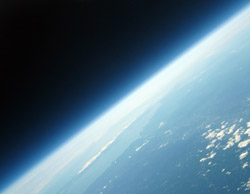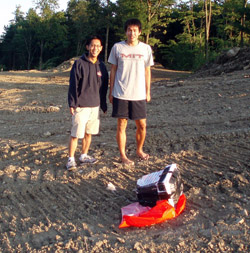View the Edge of Space for Just $150
-
-
slice.mit.edu
- 1
Filed Under
Recommended

Three MIT engineering students have found a way to stretch $150—93,000 feet (17.6 miles) into the uppermost parts of the stratosphere, to be exact.
The trio, senior Oliver Yeh and grad students Justin Lee and Eric Newton, photographed the earth from near-space using a helium-filled 350g balloon and off-the-shelf components. While high-altitude balloon photography has existed for some time and others have successfully undertaken similar ventures into the stratosphere, this (as far as the students know) is the first time it's been done on a shoestring budget and with equipment the average non-MIT person can configure—no electronic hacking required.
The team used a prepaid cell phone with GPS capability, a cell phone charger, Energizer lithium batteries (which withstand temperatures as low as -40 degrees Fahrenheit) for the charger and the camera, a Styrofoam beer cooler, disposable hand warmers to safeguard the equipment against frigid high-altitude temps, a used Canon camera they loaded with open-source software to enable continuous pictures (intervalometer), and an eight gigabyte memory card, among a few other items. See the entire list of hardware used.

Called Project Icarus, the balloon's ascent took about four hours; its descent took 40 minutes. The group tracked the device with GPS and found it some 20 miles from the launch site. And in case you're wondering, no, they did not violate any FAA regulations, which only apply to balloons with payloads over four pounds. Learn about the entire project from start to finish on their Web site, 1337arts.com, which seeks to promote the beauty of scientific art by combining traditional media and methods with state-of-the-art science. They promise to post DIY instructions and video soon.
While you're there, also check out what the trio calls Skyviews—high-quality aerial photos using cameras tethered to balloons. The results are some stunning views of Boston and campus—made more impressive when you consider the variables they have to overcome: wind velocity, turbulence, lighting, and location. Photos can be purchased.








Comments
Satish Chaudhri
Tue, 09/22/2009 2:10am
Well done guys! You should have put a brick in it, it would have traveled further (inertia and momentum!) and who knows we might have been half way to the moon with with it!
Very well done guys! kudos!!
Regards, satish